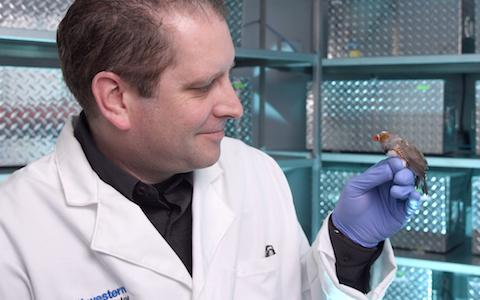
Credit: UT Southwestern
DALLAS – Researchers have identified a network of neurons that plays a vital role in learning vocalizations by aiding communication between motor and auditory regions of the brain.
A new study from the Peter O'Donnell Jr. Brain Institute demonstrates in songbirds the necessity of this neural circuit to learn vocalizations at a young age, a finding that expands the scientific understanding of some contributing factors in speech disorders in humans.
"Speech and language learning depend on our ability to evaluate how accurately we are producing the particular sounds associated with speech," said Dr. Todd Roberts, Assistant Professor of Neuroscience with the O'Donnell Brain Institute at UT Southwestern Medical Center. "This evaluation has long been thought to rely on close interactions between auditory and speech-related motor areas of the brain, but identification of specific brain pathways involved in this process has been challenging."
Songbird Extras
- Brain Mapping: BRAIN Initiative study
- The Missions: Roberts Songbird Lab
Researchers in Dr. Roberts' songbird lab used zebra finches to study how brain circuits learn and control song. They found a network of neurons in the brain's motor cortex that sends a copy of vocal commands – what the bird intends to sing – to the auditory cortex. It is thought that as the birds hear themselves sing, this brain pathway helps them compare their produced sounds to what they intended to sing.
The study featured on the cover of July's Nature Neuroscience showed that disabling the neurons in this pathway impeded juvenile songbirds' ability to learn a new song. Adult songbirds were able to sing what they had previously learned but could no longer learn to change the timing and tempo of their song.
"To understand and address the causes of speech disorders requires a fundamental understanding of the brain circuits and computations involved in learning and controlling speech," said Dr. Roberts, a Thomas O. Hicks Scholar in Medical Research. "This new study is revelatory in the sense that it pinpoints a brain circuit long speculated to perform important computations involved in speech learning and provides the first proof that this circuit is critical to learning vocal behaviors."
The research complements other work being done in Dr. Roberts' lab, including an ongoing study funded by the federal BRAIN Initiative research program to understand how the brain functions during vocal learning. By mapping the neural processes involved as birds learn mating songs, scientists hope to someday use that knowledge to target specific genes disrupting speech in patients with autism or other neurodevelopmental conditions.
###
The Nature Neuroscience study received support from the National Institutes of Health, National Science Foundation, the Brain & Behavior Research Foundation, and the Klingenstein-Simons Fellowship.
Other collaborators include Gaurav Chattree, a medical student at UTSW; Dr. Richard Mooney, Erin Hisey, Dr. Masashi Tanaka, and Matthew Kearney from Duke University Medical Center; and Drs. Nirao Shah and Cindy Yang from University of California San Francisco.
About UT Southwestern Medical Center
UT Southwestern, one of the premier academic medical centers in the nation, integrates pioneering biomedical research with exceptional clinical care and education. The institution's faculty has received six Nobel Prizes, and includes 22 members of the National Academy of Sciences, 18 members of the National Academy of Medicine, and 14 Howard Hughes Medical Institute Investigators. The faculty of more than 2,700 is responsible for groundbreaking medical advances and is committed to translating science-driven research quickly to new clinical treatments. UT Southwestern physicians provide care in about 80 specialties to more than 100,000 hospitalized patients, 600,000 emergency room cases, and oversee approximately 2.2 million outpatient visits a year.
###
This news release is available on our website at http://www.utsouthwestern.edu/newsroom.
To automatically receive news releases from UT Southwestern via email, subscribe at http://www.utsouthwestern.edu/receivenews.
Media Contact
James Beltran
[email protected]
214-648-3404
@UTSWNews
http://www.swmed.edu
############
Story Source: Materials provided by Scienmag





